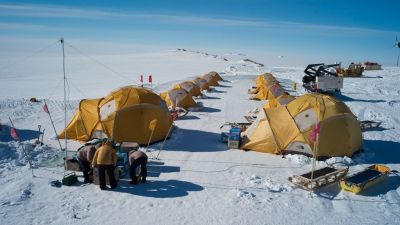
Start-up of the station: the first tests for the engines
After a few days in Cape Town (where the weather was very rainy), we are now 10 men and one woman at Utsteinen. The flight from Cape Town to Utsteinen via Novo air-base (Russian base) went very well. After unloading the Ilyushin, which was better organized than last year, we were surprised to be the first ones to be allowed to board the continental flight in a Basler DC3. This flight also went very well, and we had very good weather: sunny with blue skies and no wind, although it was very cold (-15°C).
It was a very calm flight and an easy landing. Once the Basler was unloaded, we started up the skidoos stored in a nearby container and rode to the station, which appeared to be in good condition. The back of the station, where the workplace and the storage rooms are located, was entirely snowed under, more so than last year. Lots of snow was blocking the doors, and some solar panels had been covered by snow, too.
Assessing the damage, we could see that some containers had been moved around, and there was even one that seemed to have flipped over a few times before stopping against another container. The snow melter unit was buried under a mass of snow and appeared completely bent out of shape in all directions, while containers under the snow were completely deformed. In the station, several pumps were cracked and the batteries were swollen. This can mean only one thing: last winter was harsher than in previous years. The mess tent we'd left behind last year was buried in snow. Although it was a little bent at the mid-section, it was still useable.
Once they got the bulldozer (Big Bull) started, Elire and Swa started clearing the snow away in front of the station. In the garage, where the temperature is always -20°C, we checked the engines of the vehicles, which seemed to be working without too much trouble. The mechanics (Kristof and I) started the generators, snow tractors, and skidoos before doing some maintenance on them after their long winter hibernation. After a few more repairs, everything was up and running.
The following day, vehicles were checked and serviced one by one with spare parts from the storage area. These were long and busy days, working from 9:00 am-8:00 pm, checking to see if every last piece of equipment was working properly.
The station needed a couple of days to warm up from 0°C to 20°C, which is no luxury since outside it's -25°C. The rooms at the station are fairly comfortable; they sleep three to four people, and we've slept very well so far. But this will change next week when we'll be back in our tents. There's still a lot of work to be done inside the station such as wiring, plumbing and woodworking. In the meantime, the Japanese have arrived. They are well-disciplined: they all wear the same snowsuits, and they have nicely striped tents, skidoos and emblems. This year's Japanese expedition is called JARE 51, which means it is the 51st Japanese Research expedition in Antarctica. A few evenings of socializing around some red wine and sake seem to be a rather pleasant way to spend the time for both parties.
Doing the dishes, or going for snow to make drinking water, or doing the dishes after dinner are still daily chores for the moment. We usually go to sleep between midnight and 1:00 am. When the sun rises over the mountains again, it means it's high time to hit the hay. Since today the Internet has been working again. It's a little slow, but not too bad by our standards if we can find some time to surf the net.
That's all for now. Greetings from the Far South,
Jesko Kaczynski
Picture: International Polar Foundation - © International Polar Foundation
